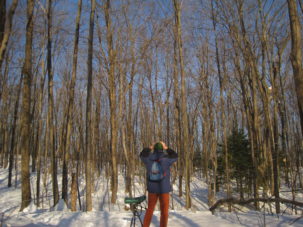 Bird counts are important in order to monitor and study the complex distribution and movements of so many species in such a short time. Events like this help to describe the “big picture” of bird populations. Visit gbbc.birdcount.org to view a live map of counts submitted from around the world and more summary information on this year’s Great Backyard Bird Count event.
Bird counts are important in order to monitor and study the complex distribution and movements of so many species in such a short time. Events like this help to describe the “big picture” of bird populations. Visit gbbc.birdcount.org to view a live map of counts submitted from around the world and more summary information on this year’s Great Backyard Bird Count event.
Our small group of bird enthusiast took advantage of beautiful weather this past Saturday and hiked the two mile outer trail loop in Skidmore’s North Woods. We saw the unique upside down foraging behavior of the White-breasted Nuthatch, heard the songs of the Tufted Titmouse, and observed Downy, Harry, and Red-bellied Woodpeckers throughout the North Woods. Saratoga PLAN and SAAS are committed to the preservation of natural habitats and ecologically important species from across the region. SAAS president John Loz is “looking forward to future opportunities to promote birding across Saratoga County, and engage the public in habitat conservation.” For more birding opportunities, check out Saratoga PLAN’s properties, including Galway and Woodcock Preserves, the boardwalk on the Bog Meadow Trail off Meadowbrook Road in Saratoga Springs, and the Ballston Creek Preserve which provides habitat for the Great Horned Owl, Osprey, and a long-term Heron Rookery.
This was the fourth in a series of events that aim to bring the public and experts together to explore the ecosystems of the Palmertown Conservation Area, a natural landscape bordered to the North by the Hudson River, with Routes 9 and 9N to the East and West. PLAN’s first event learned about active forest management to address beech bark disease and deer overbrowse in Lincoln Mountain State Forest led by DEC Forester Rich McDermott, and included a visit to ancient Black Gum trees. The second event toured winter evergreens around Mud Pond in Moreau Lake State Park under the guidance of expert naturalist, Jackie Donnelly. The third shared the fundamentals of animal tracking and winter ecology at Vince Walsh’s Kawing Crow Awareness Center in Greenfield. Future events are planned as the weather warms up in the spring. These events offer opportunities for the public to learn about areas within the Palmertown Conservation Area and to engage with expert naturalists.
Saratoga PLAN is focusing attention on the Palmertown Conservation Area as a conservation priority. The area includes unfragmented forests which provide important wildlife habitat and timber, and protect the headwaters of the Snook Kill and Kayaderosseras Creek. A detailed landscape analysis identified the landscape’s high potential for groundwater recharge and resiliency, two important ecosystem functions. The Palmertown Conservation Area also contains existing public lands and trail systems, which can be linked together to create a long distance trail network connecting communities and providing recreation opportunities that span the landscape.
The Palmertown exploratory events are supported by funding from New York State’s Conservation Partnership Program for land trusts helping to accomplish New York’s Open Space goals.
Saratoga PLAN is a nonprofit land trust that works to preserve the rural character, natural habitats and scenic beauty of Saratoga County so that these irreplaceable assets are accessible to all and survive for future generations. PLAN helps landowners conserve farmland, woodlands and natural habitats. PLAN connects people to nature through an extensive trail network, including 10 public nature preserves open for hiking, biking, cross country skiing, snowshoeing, and kayaking. Saratoga PLAN helps communities create plans that balance growth with conservation to sustain the Saratoga Region as a great place to live, work, visit, play and farm. PLAN facilitates community-based conservation by partnering with municipalities to help them accomplish their community’s conservation goals.
